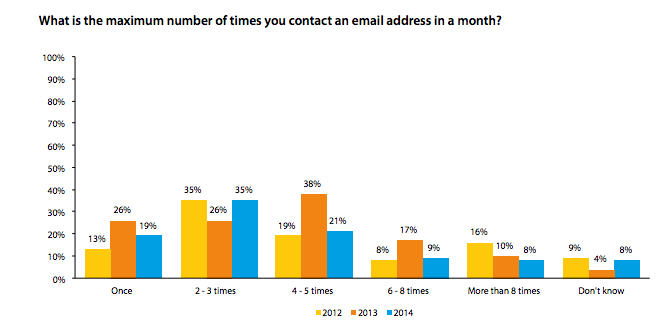Meet email savvy Emma. Apart from being a self-confessed technophile, she's also selective and fickle. But she’s loyal to brands who consistently provide value and create engaging email content. If she thinks you’re sending out uninteresting content in her inbox more often than you should, she’s quick to click the unsubscribe button!
How do you know if you’re not irritating Emma with your email marketing frequency? Is there a right frequency?
Prospects like Emma willingly subscribe to your email list because you’ve captured their attention through one of your marketing campaigns. Plus, you promised consistent delivery of value without being meddlesome.
In this blog post, you’ll learn how to keep Emma from flagging your email as spam by finding out the ideal frequency of your marketing emails.
Send Frequency: A Marketer's Perspective
According to this 2015 National Client Email report by the Direct Marketing Association, the following chart covers the email frequency for 2014 among marketers from various company types and sizes as well as geographic locations.

- 19% of marketers send a maximum of one message per month
- 35% of marketers send 2 to 3 emails per month
- 21% of marketers send 4 to 5 emails per month
- 9% of marketers send 6 to 8 emails per month
Based on the aforementioned figures, the majority of marketers (54 percent) send out 1-3 emails a month.
Keep in mind that the same report emphasizes how frequency should play second fiddle to producing interesting and relevant content in terms of email marketing strategy.
Send Frequency: A Customer's Perspective
Now that we’ve figured out the average send frequency among marketers, let’s take a look at the preferred email frequency of customers.
According to a survey by Marketing Sherpa between Jan. 21 to 23 last year, 61% of the 2,057 respondents surveyed said they would like to receive promotional email "at least weekly”.
Meanwhile, 86% don’t mind receiving promotional emails at least monthly and 15% would like to receive promotional emails every day.
Apart from the frequency, the same benchmark study by Marketing Sherpa revealed that 91% of the respondents have no qualms at all about receiving promotional emails.
Finding the Send Freqency Sweet spot
In analyzing over two billion emails from companies with less than 25,000 subscribers (who sent 5 emails within 3 months), the Campaign Monitor team found out that the highest overall open rate occurs after the first email campaign.
Based on the same set of data, they were also able to identify what they refer to as the email frequency sweet spot, where it’s possible to get the most people to see your emails without burning out your subscriber list.
How often is this sweet spot? Sending emails every two weeks.
Test As You Go
Despite what some gurus and influencers will tell you, there is no one-size-fits-all approach in sending frequency. You can use the aforementioned findings as benchmarks in coming up with your own email frequency standards.
As HubSpot’s Corey Wainright writes, every brand's email marketing campaign goals and subscriber lists are not the same. To optimize your email campaigns, you need to test as you go to determine your own sending frequency sweet spot.
Quick Tips to Help You Find the Sweet Spot
The right frequency is established after knowing what works best for your audience. Check your captured user data and automation workflows to provide optimum results.
While you’re still testing and figuring out the right frequency for your brand and corresponding marketing objectives, consider the following guidelines.
Set expectations for the frequency and timing of your emails on the opt-in page.
Although you may be still figuring out the best frequency, let your subscribers know what to generally expect. You can let them choose their own frequency preference later on once you’ve established a solid email cadence.
Send an email at least once a month.
If you're not sending out emails regularly (as you promised), your subscriber list will eventually rot and decay, even if subscribers were initially collected via double opt-in. This could result in spam complaints, unsubscribes, and high bounce rates.
Think of your subscriber list as friends in your Tier 1 Circle of Peers. It's already a given that you regularly get in touch with these friends, right?
Always provide value.
The first rule of inbound marketing is you do not go out there without creating value. The second rule of inbound marketing is you do not launch a marketing campaign without creating value.
Before hitting the send button, always ask yourself if your email content is useful and relevant to your audience. When someone subscribes to your email list, it means they trust you enough that they don't mind giving you a portion of their time and attention. Repay this act of trust by providing value.
In addition, marketing strategist Jeremy Reeves suggests that you track the following key metrics to help you identify the frequency that works for your brand: open rate, click-through rate, unsubscribe rate, and email conversion rate.
The Takeaway
Finding out what’s “best practice” in email marketing is complex. What works for a fashion retailer brand may not yield the same results for a B2B healthcare company.
To accomplish maximum results, you have to consistently test certain elements in your emails like send frequency. With easy access to email marketing tools these days, you have no excuse if Emma hits the unsubscribe button!
How often do you send emails to your subscribers? How are your open and click-through rates? Do you think you can do better?
Kyjean Tomboc finished nursing school but found joy in plucking and stringing words to create value-driven content for brands in the health, life sciences, and lean startup niches. She loves everything strategic in creating content -- from CRO to SEO to SMM to UX (the Internet sure loves acronyms!). Her current obsessions include the human gut microbiome, A/B testing, and Benedict Cumberbatch. Kyjean is also a seasoned trekker.